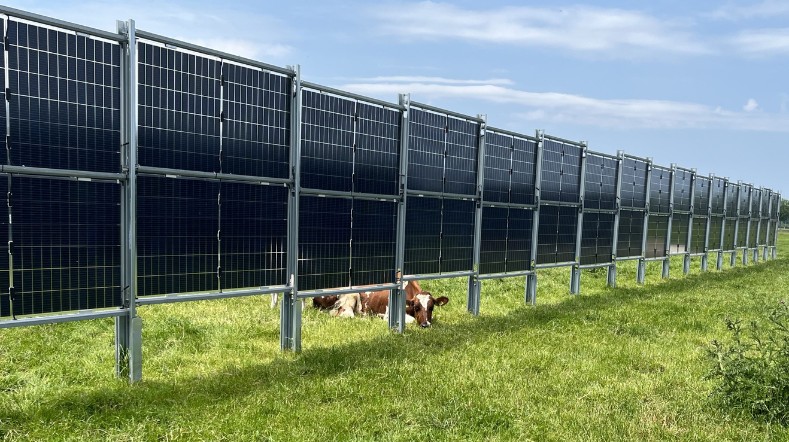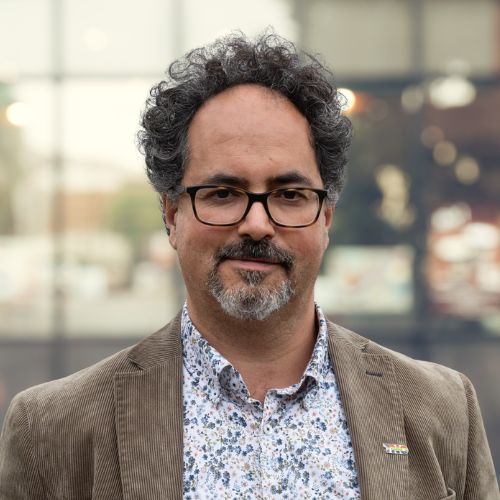
Better solar farm design needed for nature conservation
Solar farms in the countryside help accelerate the energy transition. They’re also a relatively cheap way of generating solar power. However, it must be done without harming the landscape, water and soil quality, or biodiversity. And the costs must be as low as possible. We’re investigating the possibilities.
Report on maintaining soil quality
Our simulations show that better-designed solar farms prevent the soil from drying out. You can read about our findings in the report entitled ‘Towards nature inclusive east-west orientated solar parks’.
One of the questions in this report was whether the many east-west oriented solar farms that are planned could be designed differently. The aim would be to preserve soil quality while providing the same energy yield as with north-south oriented arrays. The important factor is the amount of sunlight that reaches the ground between and under the solar panels. In many east-west solar farms, the panels are close together and cover nearly the entire plot. This causes soil quality to deteriorate over time. If a solar farm is then removed after 25 years, in line with current standards, there’s a high probability that the soil will be difficult to use for agriculture or nature development. It will then take considerable time and effort to restore the quality of the soil to the condition it was in before the solar farm was installed.
Spreading light better
Our study shows that a lot can be gained by spreading the sunlight better. Improvements can be made in particular in those parts of the solar farm where there is little light beneath the panels. Our software tool BIGEYE calculates both the efficiency of solar panels and the incidence and intensity of the light under and next to the panels in a solar farm. We looked at 2 south-facing set-ups from a previously published study by Wageningen University & Research (WUR) and compared these with conventional east-west systems. In the calculations, we looked at variations in the degree of cover, the angle made by the solar panels, and the space between them. According to the researchers, the desired design changes are possible without undermining the business case.
Bifacial panels
East-west oriented solar farms are attractive in the Netherlands thanks to the business case and the connection to the grid. We therefore calculated 2 additional variants: one with standard solar panels and one with panels that generate solar power on both sides (bifacial). This new type of panel is semi-transparent and has a higher yield because the back of the panel converts light reflected from the ground into power. A 77% coverage design with semi-transparent, bifacial panels scores better in terms of the effect on soil quality than south-facing standard panels with 53% coverage. As a result, nearly 100% of the ground receives sufficient sunlight in a situation with a high degree of ground coverage.
Economically sound
The study offers landowners, public authorities, and project developers many opportunities for a different approach to solar farm design. We not only calculatedthe impact of various set-ups on ground-level radiation. We also established that the desired design adjustments are economically feasible, particularly in comparison with solar farms that are currently deemed safe. Furthermore, at the end of the solar farm's life, the landowner will own valuable land which remains fertile. We recommend the establishment of criteria for ground irradiation under and between solar panels.
Research eco certified solar parks
Together with Wageningen University & Research (WUR), Eelerwoude, Holland Solar and NL Greenlabel, TNO is developing the certification for solar parks with ecological added value. Project developers and governments can use this certificate to demonstrate that they offer ecological added value on the basis of Holland Solar's ‘Sun on land’ code of conduct. The Eco Certified Solar Parks project is a sequel to SolarEcoPlus.
SolarEcoPlus: research into ecological effects
In partnership with LC Energy, Wageningen University & Research (WUR), Eelerwoude, and SolarCentury, we’re conducting research on the effect of solar farms on soil quality and biodiversity. In the SolarEcoPlus project, we’re selecting 6 Dutch solar farms for a research pilot. The Netherlands Enterprise Agency (RVO) is funding the project with a grant of 3.6 million euros. This initiative was created within the National Consortium Solar Energy in the Landscape.
The main goal of the SolarEcoPlus research project is to determine the ecological and economic benefits of solar farms built with innovative panels that function on both sides, bifacial panels. We’re doing this research on the most common types of soil in the Netherlands: sand, peat, and clay.
More about the SolarEcoPlus research (pdf).
In each test farm for this research, we’ll be placing bifacial solar panels totalling at least 700 kWp in 4 different ways: facing south, east-west orientation, vertical, and sun-tracking (rotating about an axis). In this way, we’ll determine the relationship between effects on soil quality, biodiversity, and energy yield. This will enable us to use quantitative data to design eco-positive solar farms. Testing solar panels positioned vertically and with a sun-tracking system in this application is a first for the Netherlands. WUR has drawn up a measuring protocol to monitor the ecological impact and compare it with a baseline measurement. We measure biodiversity both above ground (flora, birds, and insects) and below ground. Soil fertility and carbon storage in the ground are also subjects of research.
The project also aims to make a significant contribution to the bankability of bifacial systems, which is still a barrier slowing down the market introduction of this promising technology. An important challenge in this is obtaining sufficient certainty regarding the additional yield from the rear side of these panels. We are therefore measuring the yields of the various set-ups as compared to a normal solar farm which is installed adjacent to the test field.
Significant savings possible on solar farm maintenance
Land-based solar farms must have a lifespan of at least 25 years and throughout that time, they need regular maintenance. Operation and maintenance account for roughly a quarter of the costs of solar power. By accurately predicting degradation and failure during the entire lifespan, we could reduce these costs by up to 10%. We’re working on a method to achieve this.
We see opportunities to reduce management costs of solar farms. This could be done with a system that includes standardised and automatic choices for maintenance decision-making along with the associated costs and revenues. We’re testing this in the solar farms of the SolarEcoPlus project. We’ll use the data from this project to develop models and digital applications. Measurements in the solar farm will provide insight into aging mechanisms, which we can use to draw up optimum maintenance schedules. This will save owners money and help manufacturers to improve their products.
Light transmitting solar panels
Read more about the business opportunity of solar parks with panels that transmit light in 'Eco-positive bifacial module design'.
Get inspired
Wind energy webinars

Carbon footprint floating solar energy systems similar to land systems


SWITCH tackles the energy issues of the future


SWITCH field lab of TNO and Wageningen University & Research/ACRRES opened


Study solar systems in dairy farming launched



